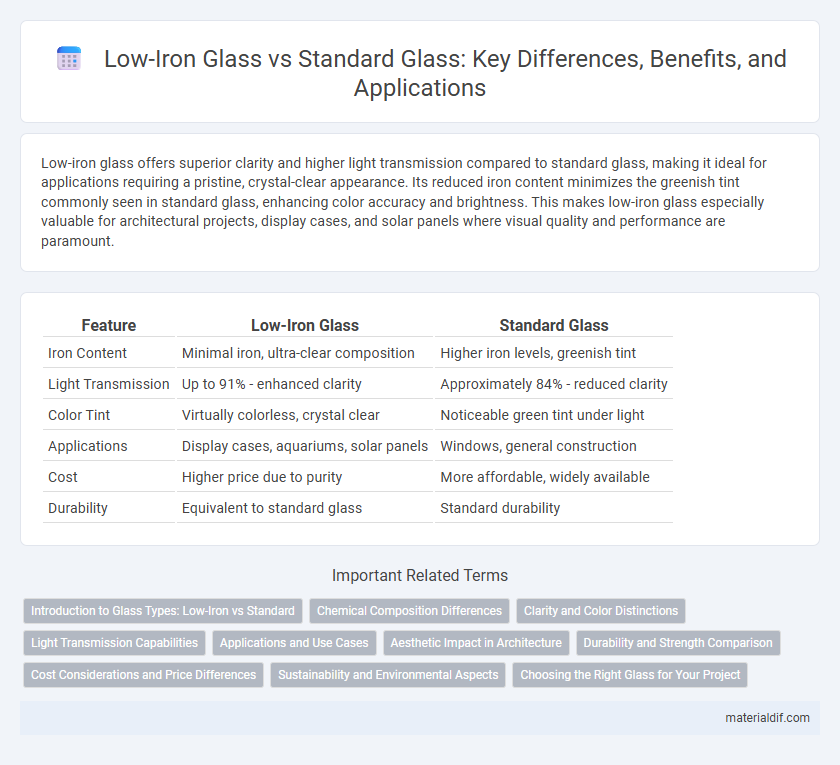Low-iron glass offers superior clarity and higher light transmission compared to standard glass, making it ideal for applications requiring a pristine, crystal-clear appearance. Its reduced iron content minimizes the greenish tint commonly seen in standard glass, enhancing color accuracy and brightness. This makes low-iron glass especially valuable for architectural projects, display cases, and solar panels where visual quality and performance are paramount.
Table of Comparison
| Feature | Low-Iron Glass | Standard Glass |
|---|---|---|
| Iron Content | Minimal iron, ultra-clear composition | Higher iron levels, greenish tint |
| Light Transmission | Up to 91% - enhanced clarity | Approximately 84% - reduced clarity |
| Color Tint | Virtually colorless, crystal clear | Noticeable green tint under light |
| Applications | Display cases, aquariums, solar panels | Windows, general construction |
| Cost | Higher price due to purity | More affordable, widely available |
| Durability | Equivalent to standard glass | Standard durability |
Introduction to Glass Types: Low-Iron vs Standard
Low-iron glass offers enhanced clarity and higher light transmission compared to standard glass, making it ideal for applications requiring true color visibility and minimal green tint. Standard glass contains iron impurities that cause a slight greenish hue, reducing transparency and brightness. Low-iron glass is commonly used in high-end architecture, display cases, and solar panels where visual performance is crucial.
Chemical Composition Differences
Low-iron glass contains a significantly reduced amount of iron oxide, typically less than 0.02%, compared to standard glass which has around 0.1-0.2% iron content. This difference in chemical composition minimizes the greenish tint in low-iron glass, resulting in higher clarity and superior light transmission of up to 91%, whereas standard glass transmits about 84-87%. The reduced iron oxide in low-iron glass enhances its performance in applications requiring true color representation and maximum transparency, such as in aquariums, display cases, and architectural glazing.
Clarity and Color Distinctions
Low-iron glass offers superior clarity compared to standard glass due to its reduced iron content, which minimizes the greenish tint commonly found in regular glass. This enhanced transparency allows for true color representation and higher light transmission, making low-iron glass ideal for applications requiring clear, vibrant visuals such as display cases and architectural features. Standard glass, with higher iron levels, often distorts color accuracy and brightness, resulting in a noticeable green hue that can impact aesthetic and functional outcomes.
Light Transmission Capabilities
Low-iron glass exhibits significantly higher light transmission compared to standard glass, allowing for clearer and more vibrant visuals. With light transmission rates often exceeding 90%, low-iron glass reduces the greenish tint found in standard glass, which typically transmits around 80-85% of visible light. This enhanced clarity makes low-iron glass ideal for applications requiring maximum natural light and true color representation.
Applications and Use Cases
Low-iron glass offers enhanced clarity and higher light transmission, making it ideal for applications in architectural facades, display cases, and solar panels where visual purity and color accuracy are critical. Standard glass, with its green tint, is commonly used in windows, mirrors, and general construction where cost-efficiency takes precedence over optical performance. Specialized uses such as museum showcases and aquariums benefit from low-iron glass to provide true color representation and minimal distortion.
Aesthetic Impact in Architecture
Low-iron glass offers superior clarity and transparency compared to standard glass, enhancing natural light transmission and creating a more vivid, true-to-life appearance in architectural designs. Its reduced green tint allows for cleaner, brighter facades and interior spaces, making it highly desirable for modern buildings seeking sleek, minimalist aesthetics. Standard glass, while cost-effective, often imparts a slight greenish hue that can diminish visual purity and alter color perception in both exterior and interior applications.
Durability and Strength Comparison
Low-iron glass offers enhanced durability compared to standard glass due to its higher purity and reduced iron content, which minimizes brittleness and improves resistance to impacts. Standard glass typically contains higher iron levels, making it more susceptible to stress fractures and surface scratches over time. The strength of low-iron glass is often preferred in applications requiring long-term structural integrity and superior performance under mechanical stress.
Cost Considerations and Price Differences
Low-iron glass typically costs 20-40% more than standard glass due to its higher purity and enhanced clarity, making it a premium choice for projects demanding superior aesthetics. Standard glass offers a more budget-friendly option suitable for general applications where slight green tint is acceptable. The price disparity reflects the manufacturing process and raw material quality, influencing both initial investment and long-term value.
Sustainability and Environmental Aspects
Low-iron glass offers enhanced transparency and durability with a reduced environmental impact compared to standard glass, as it requires less energy for production due to its lower iron content, which reduces impurities and increases recyclability. The increased clarity of low-iron glass allows for better natural light penetration, decreasing the need for artificial lighting and thus lowering energy consumption in buildings. Sustainable manufacturing processes of low-iron glass contribute to reduced carbon emissions, making it a more eco-friendly alternative in architectural and automotive applications.
Choosing the Right Glass for Your Project
Low-iron glass offers higher clarity and enhanced light transmission compared to standard glass, making it ideal for projects requiring true color representation and maximum brightness. Standard glass contains higher iron content, resulting in a greenish tint that can affect aesthetics but remains a cost-effective option for general use. Selecting between low-iron and standard glass depends on balancing budget constraints with the desired visual quality and application requirements.
Low-iron glass vs Standard glass Infographic

 materialdif.com
materialdif.com